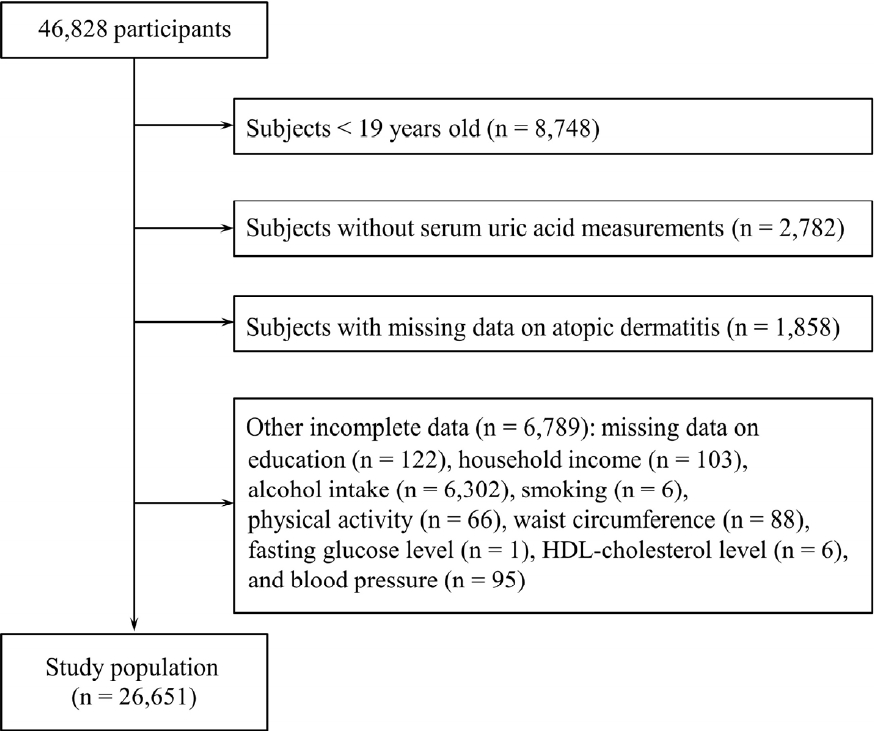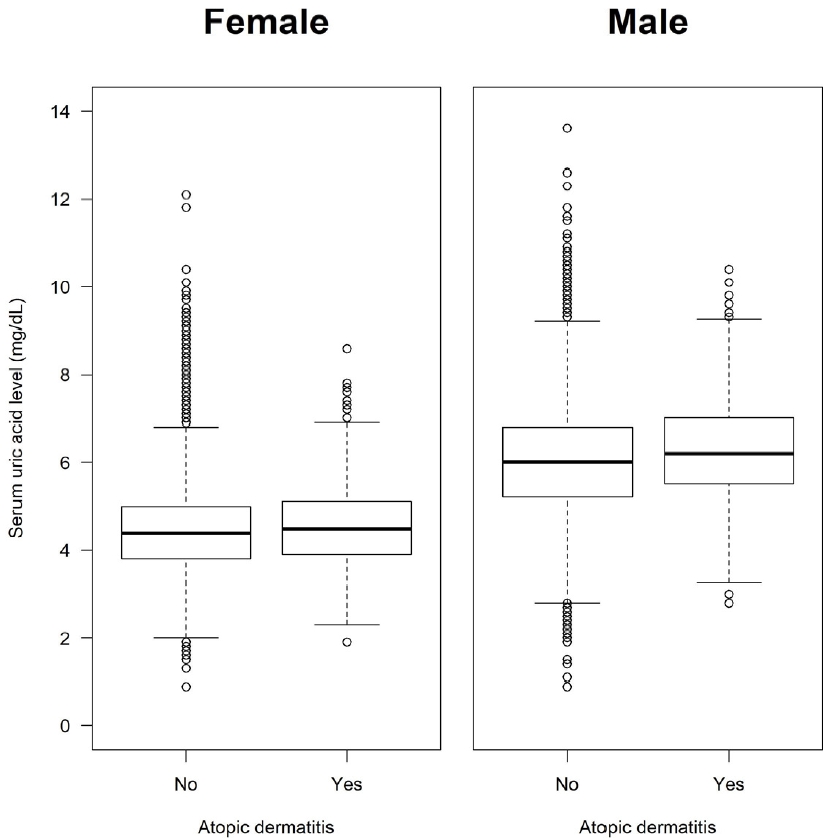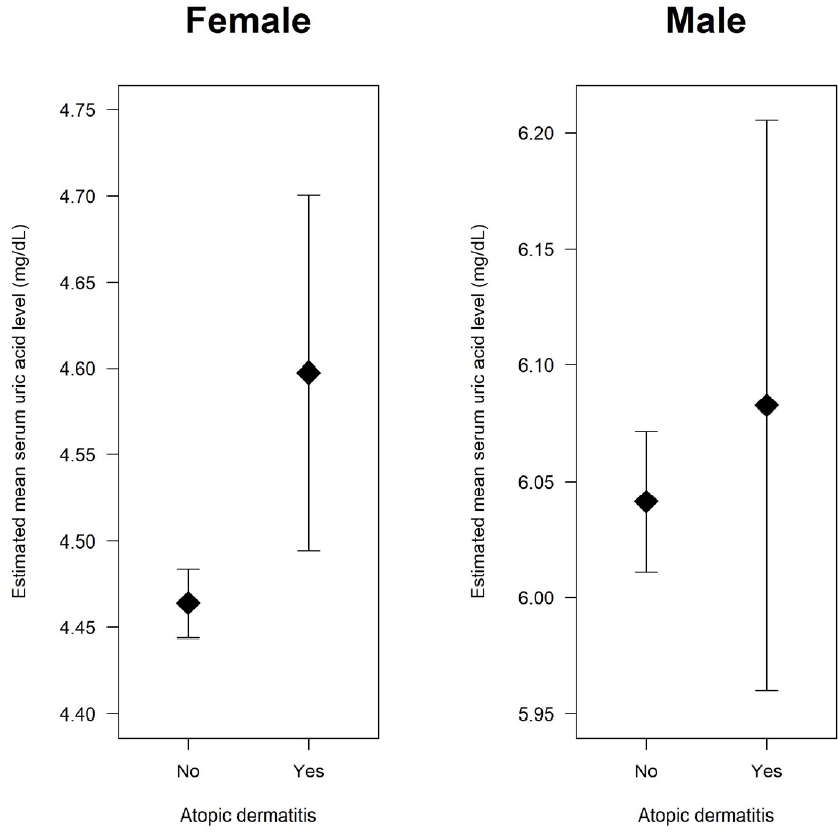Korean J Health Promot.
2023 Dec;23(4):198-208. 10.15384/kjhp.2023.23.4.198.
Association between Atopic Dermatitis and Hyperuricemia in the Adult Korean Population based on the 7th and 8th Korea National Health and Nutrition Examination Survey
- Affiliations
-
- 1Department of Family Medicine, Kangwon National University Hospital, Kangwon National University College of Medicine, Chuncheon, Korea
- KMID: 2549690
- DOI: http://doi.org/10.15384/kjhp.2023.23.4.198
Abstract
- Background
Serum uric acid levels have been reported to be associated with various conditions including psoriasis and metabolic syndrome, but their relationship with atopic dermatitis has not been studied adequately. This study aimed to investigate the association of atopic dermatitis with serum uric acid level and hyperuricemia in adult females and males.
Methods
Using data from the 7th and 8th Korea National Health and Nutrition Examination Survey, multiple linear and logistic regression analyses were performed to assess the association of atopic dermatitis with serum uric acid level and hyperuricemia respectively, with adjustment for potential confounding factors in females and males aged 19 years or older, respectively.
Results
The study population included 14,504 female and 12,147 male participants. When adjusting for potential confounding factors, females with atopic dermatitis had a mean serum uric acid level of 0.13 mg/dL (95% confidence interval [CI], 0.03-0.24) higher than those without atopic dermatitis (P=0.013), and hyperuricemia was also more frequent in females with atopic dermatitis than those without atopic dermatitis (adjusted odds ratio, 1.86; 95% CI, 1.27-2.72; P=0.002). On the other hand, there were no significant differences in mean serum uric acid level and frequency of hyperuricemia between males with and without atopic dermatitis when adjusting for potential confounding factors.
Conclusions
These results show a close relationship of atopic dermatitis with elevated serum uric acid level and hyperuricemia in Korean adult females but not males.
Figure
Reference
-
1. Kwon HH, Kwon IH, Choi JW, Youn JI. Cross-sectional study on the correlation of serum uric acid with disease severity in Korean patients with psoriasis. Clin Exp Dermatol. 2011; 36(5):473–8.
Article2. Nicolae I, Tampa M, Ene CD, Mitran CI, Mitran MI, Sarbu MI, et al. Correlations between related-purine derivatives and renal disorders in patients with psoriasis vulgaris. Exp Ther Med. 2019; 17(2):1012–9.
Article3. Bazid HAS, Shoeib MA, El-Sayed S, Mostafa MI, Shoeib MM, Eldeen ES. Study of purine derivatives and their relation to renal disorders in patients with psoriasis. Int J Dermatol. 2023; 62(1):73–8.
Article4. Niehues H, Rikken G, van Vlijmen-Willems IMJJ, Rodijk-Olthuis D, van Erp PEJ, Zeeuwen PLJM, et al. Identification of keratinocyte mitogens: implications for hyperproliferation in psoriasis and atopic dermatitis. JID Innov. 2021; 2(1):100066.
Article5. Jeong J, Suh YJ. Association between serum uric acid and metabolic syndrome in Koreans. J Korean Med Sci. 2019; 34(48):e307.
Article6. Lee JW, Kwon BC, Choi HG. Analyses of the relationship between hyperuricemia and osteoporosis. Sci Rep. 2021; 11(1):12080.
Article7. Cheng HM, Kim S, Park GH, Chang SE, Bang S, Won CH, et al. Low vitamin D levels are associated with atopic dermatitis, but not allergic rhinitis, asthma, or IgE sensitization, in the adult Korean population. J Allergy Clin Immunol. 2014; 133(4):1048–55.
Article8. Sun Y, Zhang H, Tian W, Shi L, Chen L, Li J, et al. Association between serum uric acid levels and coronary artery disease in different age and gender: a cross-sectional study. Aging Clin Exp Res. 2019; 31(12):1783–90.
Article9. Lee B, Ha J. The effects of smoking and drinking on blood lead and cadmium levels: data from the fourth Korea national health and nutrition examination survey. Korean J Occup Environ Med. 2011; 23(1):31–41.
Article10. Lee MY, Kim MY, Kim SY, Kim JH, Kim BH, Shin JY, et al. Association between alcohol intake amount and prevalence of metabolic syndrome in Korean rural male population. Diabetes Res Clin Pract. 2010; 88(2):196–202.
Article11. Yuan H, Kim MK. Prevalence of metabolic syndrome and related factors based on smoking status and physical activity in Korean adult men. Korean J Health Promot. 2023; 23(2):75–84.
Article12. Kurtze N, Rangul V, Hustvedt BE. Reliability and validity of the international physical activity questionnaire in the Nord-Trøndelag health study (HUNT) population of men. BMC Med Res Methodol. 2008; 8:63.
Article13. Kim Y, Shin S, Hong N, Rhee Y. Low serum vitamin E level associated with low hand grip strength in community-dwelling adults: Korean National Health and Nutrition Examination Survey (KNHANES VII) 2016-2018. Nutrients. 2021; 13(5):1598.
Article14. Chiou WK, Wang MH, Huang DH, Chiu HT, Lee YJ, Lin JD. The relationship between serum uric acid level and metabolic syndrome: differences by sex and age in Taiwanese. J Epidemiol. 2010; 20(3):219–24.
Article15. Alatalo PI, Koivisto HM, Hietala JP, Bloigu RS, Niemelä OJ. Gender-dependent impacts of body mass index and moderate alcohol consumption on serum uric acid--an index of oxidant stress status? Free Radic Biol Med. 2009; 46(8):1233–8.
Article16. Walton R, Block WD, Heyde J. A comparative study of uric acid values of whole blood in patients with psoriasis and other dermatoses. J Invest Dermatol. 1961; 37:125–33.17. Portugal-Cohen M, Horev L, Ruffer C, Schlippe G, Voss W, Ma'or Z, et al. Non-invasive skin biomarkers quantification of psoriasis and atopic dermatitis: cytokines, antioxidants and psoriatic skin auto-fluorescence. Biomed Pharmacother. 2012; 66(4):293–9.
Article18. Abbas WF, Hassan MB. Evaluation of the level of variables related to allergic rhinitis. African Journal of Advanced Pure and Applied Sciences (AJAPAS). 2023; 2(2):244–54.19. Wang H, Jia Y, Yi M, Li Y, Chen O. High serum uric acid was a risk factor for incident asthma: an open cohort study. Risk Manag Healthc Policy. 2020; 13:2337–46.20. Sautin YY, Johnson RJ. Uric acid: the oxidant-antioxidant paradox. Nucleosides Nucleotides Nucleic Acids. 2008; 27(6):608–19.
Article21. Koch M, De Keyser J. Uric acid in multiple sclerosis. Neurol Res. 2006; 28(3):316–9.
Article22. Hooper DC, Spitsin S, Kean RB, Champion JM, Dickson GM, Chaudhry I, et al. Uric acid, a natural scavenger of peroxynitrite, in experimental allergic encephalomyelitis and multiple sclerosis. Proc Natl Acad Sci U S A. 1998; 95(2):675–80.23. Kanbay M, Jensen T, Solak Y, Le M, Roncal-Jimenez C, Rivard C, et al. Uric acid in metabolic syndrome: from an innocent bystander to a central player. Eur J Intern Med. 2016; 29:3–8.
Article24. Pleńkowska J, Gabig-Cimińska M, Mozolewski P. Oxidative stress as an important contributor to the pathogenesis of psoriasis. Int J Mol Sci. 2020; 21(17):6206.
Article25. Briganti S, Picardo M. Antioxidant activity, lipid peroxidation and skin diseases. What's new. J Eur Acad Dermatol Venereol. 2003; 17(6):663–9.
Article26. Bertino L, Guarneri F, Cannavò SP, Casciaro M, Pioggia G, Gangemi S. Oxidative stress and atopic dermatitis. Antioxidants (Basel). 2020; 9(3):196.
Article27. Rystedt I. Long term follow-up in atopic dermatitis. Acta Derm Venereol Suppl (Stockh). 1985; 114:117–20.28. Johansson EK, Bergström A, Kull I, Melén E, Jonsson M, Lundin S, et al. Prevalence and characteristics of atopic dermatitis among young adult females and males-report from the Swedish population-based study BAMSE. J Eur Acad Dermatol Venereol. 2022; 36(5):698–704.
Article
- Full Text Links
- Actions
-
Cited
- CITED
-
- Close
- Share
- Similar articles
-
- Association between social economic status and atopic dermatitis in Korean adult: an analysis of the Fifth Korea National Health and Nutrition Examination Survey (2010-2012)
- Prevalence of Hyperuricemia and Its Association with Obesity in Korean Adults: Analysis Based on 2018 Korea National Health and Nutrition Examination Survey
- Factors Affecting the Improvement of Adult Atopic Dermatitis in Their 20s and 30s: The Seventh Korean National Health and Nutrition Examination Survey, 2016–2018
- Factors Affecting Asthma and Atopic Dermatitis in Korean Children: A Population-based Cross-sectional Survey
- Factors associated with Atopic Dermatitis in Korean Adults: The Korean National Health and Nutrition Survey 2008




